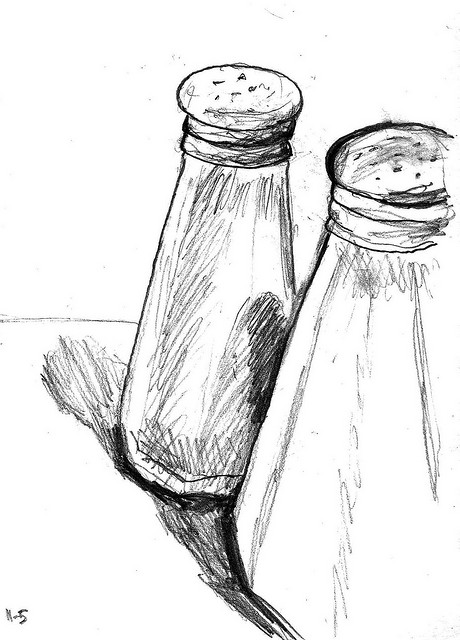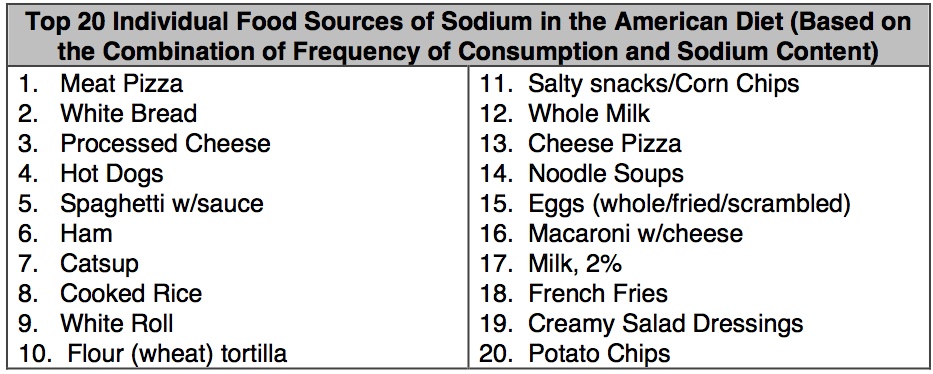The Lowdown on Salt
 When you hear people talk about salt in their diet what they're really referring to is sodium chloride. Sodium has been a mainstay for decades in just about every dish we put on our kitchen table. In fact, it has become more widely used than any other single ingredient in today's cooking world. Salt is literally in everything, and it's taking its toll on public health.
When you hear people talk about salt in their diet what they're really referring to is sodium chloride. Sodium has been a mainstay for decades in just about every dish we put on our kitchen table. In fact, it has become more widely used than any other single ingredient in today's cooking world. Salt is literally in everything, and it's taking its toll on public health.
There are ways to consume healthy amounts of sodium in your diet though. To do this, you need to be more informed and proactive about the foods and beverages you choose to eat or drink. Let's take a look at what this means and learn more about the steps that can be taken to reduce the overall amount of sodium in your diet.
A Few Facts on Sodium, Diet, and Health
Sodium plays many important roles in the body. The main function of sodium is to regulate water balance in the body, which helps control blood pressure. In addition, it performs other tasks such as ensuring proper nerve and muscular function, participates in a number of cellular chemical reactions, and aids in many different membrane transport processes.1 Without sodium we wouldn't be able to survive. However, it's easy to get too much sodium, and almost impossible to get too little.
Here's a look at some statistics on sodium:
- The average daily sodium intake for Americans (ages 2 and up) was 3,300 mg according to the 2007-2008 National Health and Nutrition Examination Survey.2 Remember though, people tend to under report unhealthy behaviors when surveyed. Many experts believe a more accurate range for daily sodium intake by individuals in the U.S. is between 3,000 and 5,000 mg/day.
- The Yanomamo Indians of Brazil survive on an average of only 585 mg of sodium chloride per day.3
- 69.2% of adults in the U.S. consume too much sodium which increases their risk of developing high blood pressure, leading to heart attacks and strokes.4
- A population-wide reduction in our average sodium intake to 1,200 mg/day would reduce the annual number of new cases of coronary heart disease by 60,000 to 120,000 cases and cut the total number of strokes by 32,000 to 66,000 in the United States.5
- Approximately 102,000 deaths in 2005 in the U.S. were due to high dietary salt intake.6
**Dr. Mike Magee does a fantastic job of summarizing the effects of sodium on your health in the video below**
Common Sources of Sodium in the American Diet
Over 75% of sodium intake comes from processed foods and foods served at restaurants.7 Only about 10% of total sodium intake comes from natural whole foods, and another 5-10% comes from using the salt shaker at the table or when cooking. Below you will find a table of twenty individual food sources of sodium in the American diet.

Source: NHANES 2003-2004 (Data Analysis Provided by General Mills Bell Institute of Health & Nutrition.)
How Much Sodium Do You Need?
According to the 2015 Dietary Guidelines for Americans and the World Health Organization the recommendations for daily sodium intake are as follows:7,8
Dietary Guidelines for Americans
Adults with prehypertension and hypertension - 1,500 mg/day or less
Adults and children 14 years and older < 2,300 mg/day
World Health Organization
Individuals with high blood pressure - 1,700 mg/day or less
All other individuals - 2,000 mg/day or less
Tips to Reduce Sodium in Your Diet
1) Avoid processed foods such as frozen tv dinners, frozen pizzas, canned, and packaged foods.
2) Limit how much you eat out on a regular basis. Restaurants and fast food cafes are known for their high sodium content in their food.
3) Eat a variety of plant-based whole foods such as fruits, vegetables, legumes, and whole grains. These are naturally low in sodium.
4) Read your labels when you go grocery shopping.
- Nutrition labels list sodium amounts per serving, and many products have more than one serving in them. As a general rule, you should stick to buying products that have a per serving calorie to sodium ratio of no more than 1:1. In other words, if you buy an item that has 100 calories per serving then it should contain no more than 100 mg of sodium per serving.
5) Don't use extra salt while eating or cooking. Use herbs, spices, and other no-salt seasonings to help flavor your dishes and promote good health.
*Note: Even individuals following a whole foods, plant-based diet need to keep their sodium intake to a lower level not to exceed the national guidelines listed above. Although people eating this way have a low risk of embolic stroke (caused by a clot), they still have a high risk of hemorrhagic stroke (caused by severe bleeding in the brain) if they consume the typical amounts of sodium in the average American diet.
Hemorrhagic strokes have much more severe outcomes compared to embolic strokes. Only 20% of people having a hemorrhagic stroke regain functional independence, and 40-80% will die within thirty days of having a hemorrhagic stroke.9
Asian cultures, which have a diet that consists mostly of plant-based foods but are also high in sodium, typically have higher incidences of hemorrhagic stroke compared to countries adopting a Western diet of meat, dairy, eggs, and processed foods. A total of 36% of all strokes in Japan are hemorrhagic strokes.10 Average daily sodium intake in Japan is 5,300 mg/day for men and 4,500 mg/day for women.11 In the United States, hemorrhagic strokes account for only 10-15% of all strokes, which is less than half the incidence of what Asian countries experience.9
References:
1 McCance K., Huether S. Pathophysiology: The Biologic Basis for Disease in Adults & Children. 3rd Edition. 1998; 3:87.
2 U.S. Department of Agriculture, Agriculture Research Service. 2010. Nutrient Intakes From Food: Mean Amounts Consumed Per Individual, by Gender and Age, What We Eat In America, NHANES, 2007-2008. Available: www.ars.usda.gov/ba/bhnrc/fsrg.
3 Institute of Medicine. Dietary Reference Intakes for Water, Potassium, Sodium, Chloride, and Sulfate. 2005; 6:269. Available: www.nap.edu/openbook.php?record_id=10925&page=269.
4 Ayala C., Kuklina EV., Peralez J., et al., Application of Lower Sodium Intake Recommendations to Adults --- United States, 1999--2006. March 27, 2009 58(11);281-283.
5 Bibbins-Domingo K, Chertow G, Coxson P, et al. Projected effect of dietary salt reductions on future cardiovascular disease. N Engl J Med 2010;362:590-9.
6 Danaei G, Ding EL, Mozaffarian D, Taylor B, Rehm J, Murray CJ, Ezzati M. The preventable causes of death in the United States: comparative risk assessment of dietary, lifestyle, and metabolic risk factors. PLoS Med. 2009 Apr 28;6(4):e1000058.
7 U.S. Department of Health and Human Services and U.S. Department of Agriculture. Dietary Guidelines for Americans, 2015-2020.
8 Joint WHO/FAO Expert Consultation on Diet, Nutrition and the Prevention of Chronic Diseases (2002 : Geneva, Switzerland).
9 Broderick J, Connolly S, Feldmann E, et al. Guidelines for the management of spontaneous intracerebral hemorrhage in adults: 2007 update: a guideline from the American Heart Association/American Stroke Association Stroke Council, High Blood Pressure Research Council, and the Quality of Care and Outcomes in Research Interdisciplinary Working Group. Circulation. Oct 16 2007;116(16):e391-413.
10 Yamada Y, Metoki N, Yoshida H, et al. Genetic Factors for Ischemic and Hemorrhagic Stroke in Japanese Individuals. Stroke. 2008;39:2211-2218.
11 Japanese Ministry of Health, Labour, and Welfare. Outline of Results from 2007 National Health and Nutrition Survey. Available: www.mhlw.go.jp/english/wp/wp-hw3/dl/2-064_065.pdf
